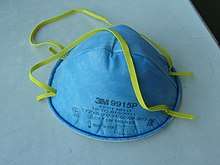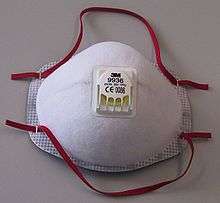FFP mask
An FFP mask (filtering facepiece mask, or respiratory protection mask or simply respirator) is a type of protective mask certified by the European Union that serves to protect against particulates such as dust particles. The EN 149 standard defines three classes of filter efficiency for these masks, namely FFP1, FFP2 and FFP3.[1][2] It is an example of a mechanical filter respirator.
The mask is a half-face mask, which means that it protects the chin, nose and mouth. The mask must meet certain standards and effectiveness tests. Efficacy is assessed by the filtration rate (filter penetration, also referred to as efficiency), as well as the degree of leakage around the edges. The mask should be correctly adjusted to the face.
This type of mask protects the wearer from inhaling infectious agents or pollutants in the form of aerosols, droplets, or small solid particles.[3]
Types
The EN 149 standard defines performance requirements for three classes of particle-filtering half masks: FFP1, FFP2 and FFP3. The protection provided by an FFP2 (or FFP3) mask includes the protection provided by a mask of the lower-numbered classes.
A mask conforming to the standard must have its class written on it, along with the name of the standard and its year of publication, as well as any applicable option codes, e.g. “EN 149:2001 FFP1 NR D”. Some manufacturers use in addition the colour of the elastic band to identify the mask class, however the EN 149 standard does not specify any such colour coding and different manufacturers have used different colour schemes.
| Class[4] | Filter penetration limit (at 95 L/min air flow) | Inward leakage | Typical Elastic Band |
|---|---|---|---|
| FFP1 | Filters at least 80% of airborne particles | <22% | Yellow |
| FFP2 | Filters at least 94% of airborne particles | <8% | Blue or White |
| FFP3 | Filters at least 99% of airborne particles | <2% | Red |
FFP1 mask

It is the least filtering mask of the three.
- Aerosol filtration percentage: 80% minimum.
- Internal leak rate: Maximum 22%.[4]
It is mainly used as a dust mask (for example for DIY jobs). Dust can cause lung diseases, such as silicosis, anthracose, asbestosis and siderose (in particular dust from coal, silica, iron ore, zinc, aluminum or even cement).
FFP2 mask

- Aerosol filtration percentage: Not less than 94%.
- Internal leak rate: Maximum 8%.[4]
This mask offers protection in various areas such as the glass industry, foundry, construction, pharmaceutical industry and agriculture. It effectively stops powdered chemicals. This mask can also serve as protection against influenza viruses such as avian influenza or severe acute respiratory syndrome associated with the coronavirus (SARS), as well as against the bacteria of pneumonic plague and tuberculosis.[5] It is similar to the N95 mask.[6]
FFP3 mask

- Aerosol filtration percentage: Not less than 99%.
- Internal leak rate: Maximum 2%[4]
The FFP3 mask is the most filtering of the FFP masks. It protects against very fine particles such as asbestos and ceramic. It does not protect against gases and in particular nitrogen oxide.[7]
Exhalation valve
Wearing a respirator for an extended period of time can become uncomfortable due to breathing resistance and buildup of heat and humidity inside the mask. To alleviate these issues and improve comfort, some masks are equipped with an exhalation valve. This valve allows the exhaled air to escape freely from the mask, avoiding condensation and preventing the filter from becoming less permeable and unpleasant to wear. FFP3 masks generally have very thick filter layers and a higher resistance, which makes breathing more difficult. For this reason, most of these masks are offered with an exhalation valve.
A mask with an exhalation valve protects the wearer just as well as a mask without a valve.[8] However, an exhalation valve allows unfiltered air to freely exit the mask. Therefore, in the case of diseases with airborne or respiratory droplet transmission (like COVID-19) a mask with a valve will not protect other people and the environment from the pathogens potentially exhaled by the person wearing such a mask.[9] In these situations, masks without exhalation valves are preferable in order to protect others. Additionally, the exhalation valve might malfunction, which could increase the risk of infiltration of contaminants or toxic dust.[10]
Proper use
The mask should be as close to the face as possible; a metal tab makes it possible to adjust the mask to the bridge of the nose. A beard is not recommended and the elastics should be shortened by a button for young children.
As a protection against infectious diseases, it is only effective in combination with frequent and effective hand washing. Hands should be washed thoroughly before putting on the mask. The mask should not be touched during use (or hands should be washed immediately). The mask should be replaced when wet. It should be removed by taking it from the back without touching the front of the mask and then placing it into a suitable closed container before washing hands again. To protect other people (and not only the wearer) the mask should not have an exhalation valve.
In March 2020, at the time of the coronavirus pandemic in the Netherlands, due to the scarcity of mouth masks the Netherlands National Institute for Public Health and the Environment (RIVM) published a (brief) advice on how to sterilize and reuse FFP masks that were originally certified for single use.[11]
Standards
FFP masks must meet certain standards. To qualify as FFP, the masks must meet the EN 149 standard.
EN 149 standard
This European standard, the first version of which dates from 2001, establishes the minimum characteristics of respiratory protection equipment. It includes laboratory tests, field tests and certain requirements to ensure the conformity of the masks. The following points are analyzed:
- Packaging
- Materials: resistance to manipulation
- Practical performance test
- Leakage: total leakage inwards and penetration of the filter material
There are some European organizations that issue an examination certificate confirming conformity and specifying the characteristics of the products:
- INRS then APAVE in France
- INSPEC in Great Britain
- FACHAUSSCHUSS in Germany
2009 version
With the publication of the 2009 version of the standard, the designation of the respiratory protection mask is now "particulate filtering half mask". The abbreviation NR or R is added after FFP1, FFP2, FFP3:
- NR (not reusable): if the use of the filtering half-face mask is limited to one working day. It is not reusable.
- R (reusable): if the filtering half-face mask can be used for more than one working day, so it is reusable.
Additional suffixes include:
- Anti-clogging NR masks (D). When the half mask has passed the dolomite dust test, a letter D can be added to indicate that the service life may exceed 8 h.[12] Example: FFP3 NR D.
- Valve. The presence of a valve can be indicated by the letter V.[13]
- Particulate type. The letters S or L respectively specify the filtration of solid dust (NaCl-only) or liquid mist (paraffin oil). Example: FFP3 SLV.
Masks manufactured before the new standard was taken into account may still have the old marking.
Legal notices
FFP respirators are considered Personal Protective Equipment (PPE). Here is the notice that should appear on every mask :
- Manufacturer's name
- Mask
- CE number of the certification body (only FFP3) + EN 149: 2009 + the mask class (FFP1, FFP2 or FFP3) + acronym (NR or R) (Note: in case of FFP1 the conformity assessment procedures are done by the manufacturer itself as per Annex IV (Module A)
- The marking must comply with Directive 89/686 / EEC[4] on PPE. If any of these entries are missing, the mask will be considered non-compliant.
Similar standards
A few other jurisdictions use FFP-like standards to govern their masks as well. They include:[6]
- Russia (GOST R 12.4.191-2011): identical.
- South Korea (KMOEL - 2017-64): considered identical to pre-2009 version. FFP1 is called "2nd grade" or KF80, FFP2 "1st grade" or KF94, and FFP3 "special grade" or KF99.[14]
- Australia and New Zealand (AS/NZ 1716:2012): similar grades with a different test agent. Grades are written simply "P".
- Brazil (ABNT/NBR 13698:2011): identical to pre-2009 version. Grades are written as "PFF".[15]
- Japan (JMHLW-Notification 214, 2018): similar grades with a different coding scheme for NR/R and S/L types. Written with a two-letter prefix D/R and S/L that maps to NR/R and S/L respectively. Leakage requirement not present.[16]
- Taiwan (CNS 14755): D1/D2/D3 grades for 80/95/99 efficiency. No requirements for inward leakage.
See also
Notes and References
- "Appareils de protection respiratoire - Demi-masques filtrants contre les particules - Exigences, essais, marquage (NF EN 149+A1)". boutique.afnor.org. AFNOR. September 2009. Retrieved 2020-04-30.
- "Respiratory protective devices - Filtering half masks to protect against particles" (PDF). cnse.gov.cn. National Special Equipment Publicity Information Query Platform, China. Retrieved 2020-04-30.
- "WIP-Richtlijn Persoonlijke beschermingsmiddelen [ZKH]" (PDF). rivm.nl. Werkgroep Infectie Preventie, RIVM. September 2015. Retrieved 2020-04-30.
- "Fiche pratique de sécurité ED 105. Appareils de protection respiratoire et métiers de la santé" (pdf). inrs.fr. INRS. Retrieved 7 April 2020.
- "Risques infectieux en milieu de soins - masques médicaux ou appareils de protection respiratoire jetables : quel matériel choisir ?". sante.gouv.fr. 27 August 2009. Retrieved 16 June 2015.
- "Technical Bulletin: Comparison of FFP2, KN95, and N95 and Other Filtering Facepiece Respirator Classes" (PDF). 3M Personal Safety Division. January 2020.
- "Vélib' et pollution, les réponses du docteur Jean-Luc Saladin". Archived from the original on 17 September 2014. Retrieved 1 June 2015.
- "Personal Protective Equipment: Questions and Answers". CDC Centers for Disease Control and Prevention. March 14, 2020. Retrieved May 3, 2020.
- Wilson, Mark (April 28, 2020). "What is a mask valve, and why are cities banning them?". Fast Company. Retrieved May 3, 2020.
- Het mondkapje als wapen tegen het coronavirus? Dat is eigenlijk zinloos, Volkskrant, 24 februari 2020
- "Reuse of FFP2 masks". RIVM.nl. Retrieved 2020-03-27.
- MOLDEX-METRIC. "La série 3000 FFP" (PDF).
- "2016 Catalogue" (PDF). VENUS Safety & Health Pvt. Ltd.
- Jung, Hyejung; Kim, Jongbo; Lee, Seungju; Lee, Jinho; Kim, Jooyoun; Tsai, Perngjy; Yoon, Chungsik (2014). "Comparison of Filtration Efficiency and Pressure Drop in Anti-Yellow Sand Masks, Quarantine Masks, Medical Masks, General Masks, and Handkerchiefs". Aerosol and Air Quality Research. 14 (3): 991–1002. doi:10.4209/aaqr.2013.06.0201.
- "ABNT/NBR 13698:2011 E quip amento de proteção respiratória — Peça semifacial fi ltrante para partículas" (PDF) (in Portuguese).
- "Standard for Dust Mask". JICOSH Home.